The humble beetle that could rescue a town
Posted on March 30th, 2021
By Nalova Akua courtesy BBC
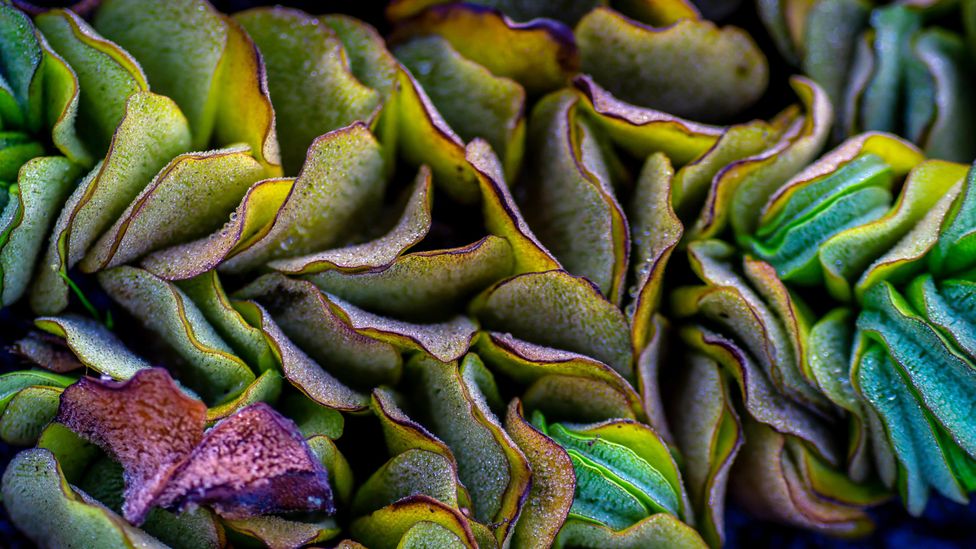
30th March 2021An invasive water weed has decimated the wildlife and economy of one of Cameroon’s most significant lakes. But a tiny, ravenous weevil could reverse the region’s fortunes.A
A flock of water birds scavenges for insects on the dense, leafy weed that covers much of Lake Ossa, one of Cameroon’s largest lakes. The water weed is so closely packed that it looks like wide, flat green pasture, and the sure-footed birds pick their way freely across it as if they were walking on land.
Five years ago, Lake Ossa was teeming with freshwater turtles, crocodiles and more than 18 families of fish. It was also a bastion of the African manatee, a species listed as vulnerable on the International Union for Conservation of Nature’s Red List. But today, the lake is eerily quiet and almost empty.
The thick layer of vegetation is Salvinia molesta, a species known locally as kariba weed or simply Salvinia, and it is the cause of this dearth of life in the lake. The invasion has been declared a “conservation emergency” by the IUCN.
Salvinia, a free-floating, green-brown freshwater fern, has already invaded more than 40% of the lake’s 4,000-hectare (15.4-sq-mile) surface, according to the African Marine Mammal Conservation Organisation (AMMCO), a Cameroonian non-governmental environmental organisation.
Not far from the lake’s shore, an army of weevils is now being mass-reared as a defence against Salvinia
Decimating the lake’s wildlife, and compromising the main source of income for the local population, the Salvinia takeover has been rapid and seemingly unstoppable. Lake Ossa is only one in a long line of freshwater bodies to be engulfed by Salvinia. As this invasive weed has spread around the world, from Brazil and Argentina to Australia, the efforts to control it have struggled to keep pace with the plant’s prolific growth.
But there is hope for Lake Ossa, and it comes in the shape of a small, innocuous-looking but remarkably powerful water-dwelling beetle. Not far from the lake’s shore, an army of weevils is now being mass-reared as a defence against Salvinia.
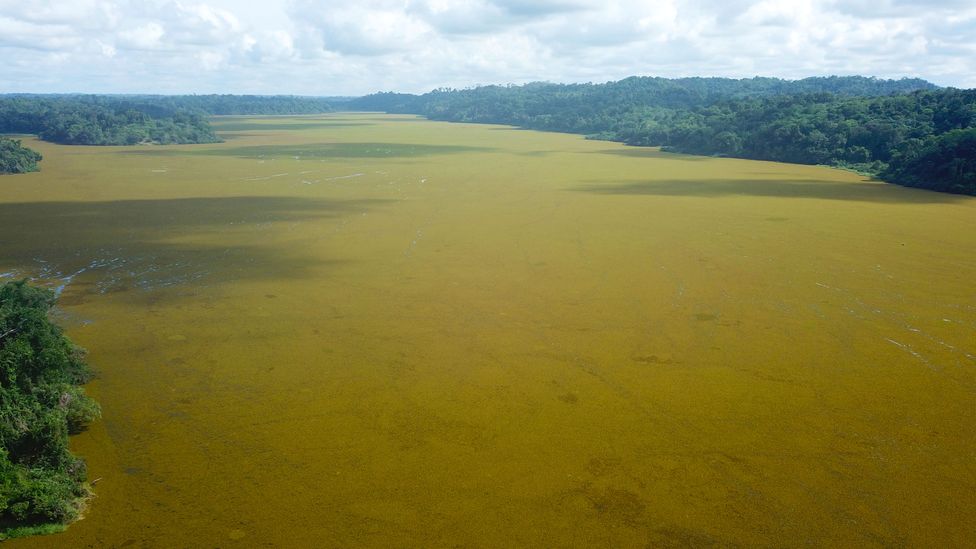
Lake Ossa is one of the largest lakes in Cameroon, and was home to a wealth of biodiversity before Salvinia arrived (Credit: AMMCO)
Lake Ossa is today littered with weed-laden fishing nets – abandoned by the local fisherfolk out of frustration. Wooden fishing boats have been hauled onto the lake’s shorelines – some have been there so long they are starting to rot. Those local fishermen who are still actively fishing in the lake, and the women who sell the fish caught, say they have lost about 80% of their income.
Lake Ossa used to be home to scores of African manatees, one of the most sparsely studied manatee species. Their population in the lake now appears to be declining
In the sweltering late morning heat, I meet Dina Marie-Louise, a fish retailer and resident of the lakeside town of Dizangue, as she disembarks from a wooden fishing boat. In the local business for 22 years, Dina has been visiting fishermen in the lake to buy their catch. Today, she frowns at the few fish in her basket. “Salvinia is killing us,” she says. “Seven of my 12 children have dropped out of school because of financial difficulties caused by Salvinia.”
Roland Ngolle, who has been fishing in the lake for 12 years, paints a similar picture. “We are running out of space to fish in this lake. If nothing is done, Salvinia will engulf all of Lake Ossa,” Ngolle says. “More than 100 fishermen used to visit this lake in a single morning. Today less than five come to fish. Everybody is discouraged.”
As well as fish, Lake Ossa used to be home to scores of African manatees, one of the most sparsely studied manatee species. Their population in the lake now appears to be declining. Many of the manatees are thought to be leaving the lake for its surrounding rivers, where they have better access to food, says Aristide Takoukam Kamla, founder of AMMCO.
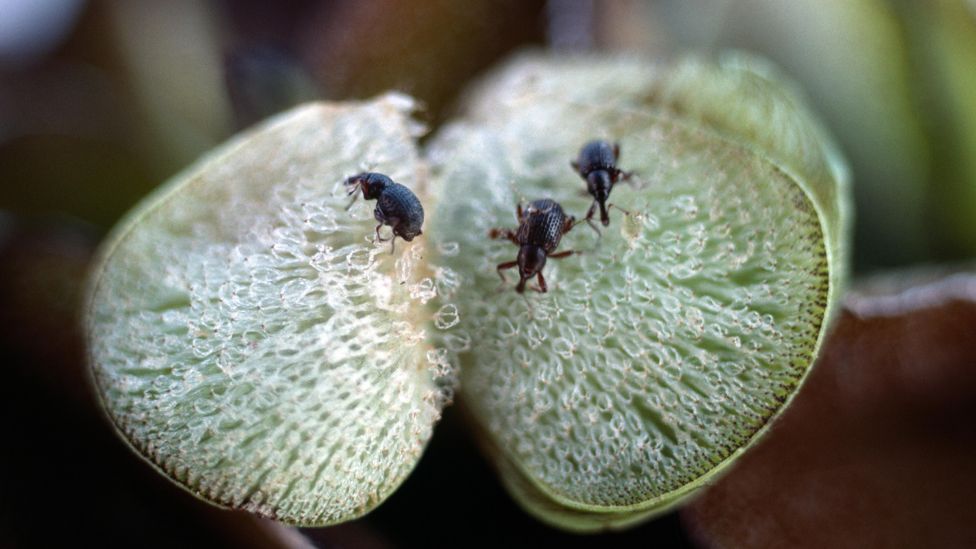
The larvae of the Salvinia weevil are highly destructive and can bring a freshwater habtitat back into ecological balance (Credit: Alamy)
Salvinia is native to southern Brazil and northern Argentina, but it can spread between water bodies by wind, water currents, floods, animals and people. “[The] human factor is partly to blame for the presence of the invasive plant in the Cameroon lake,” says Kamla.
As well as physically moving the plant from one place to another, for example when it hitches a ride on boats, human activity is also thought to be responsible for allowing Salvinia to thrive in the lake.
“We noticed a heavy concentration of nutrients such as nitrogen and phosphorous in Lake Ossa in 2016 – doubling from the historical value of 1985,” says Kamla. “This was a signal that something was happening in the lake called eutrophication, which is simply the enrichment of the lake in terms of nutrients.”
That made conditions perfect for Salvinia to proliferate. “The carpet formed by the plant at the surface prevents light from penetrating the water column and therefore reduces photosynthesis of phytoplankton on which most fish species feed,” says Kamla. “This results in a drastic depletion of fish production.”
With a fast-growing plant that can double in size every 10 days, the plant’s growth is almost unstoppable. “The absence of [Salvinia’s] natural enemies in a foreign environment facilitates its fast growth rate,” says Lum Fontem, an independent plant scientist based in Cameroon.
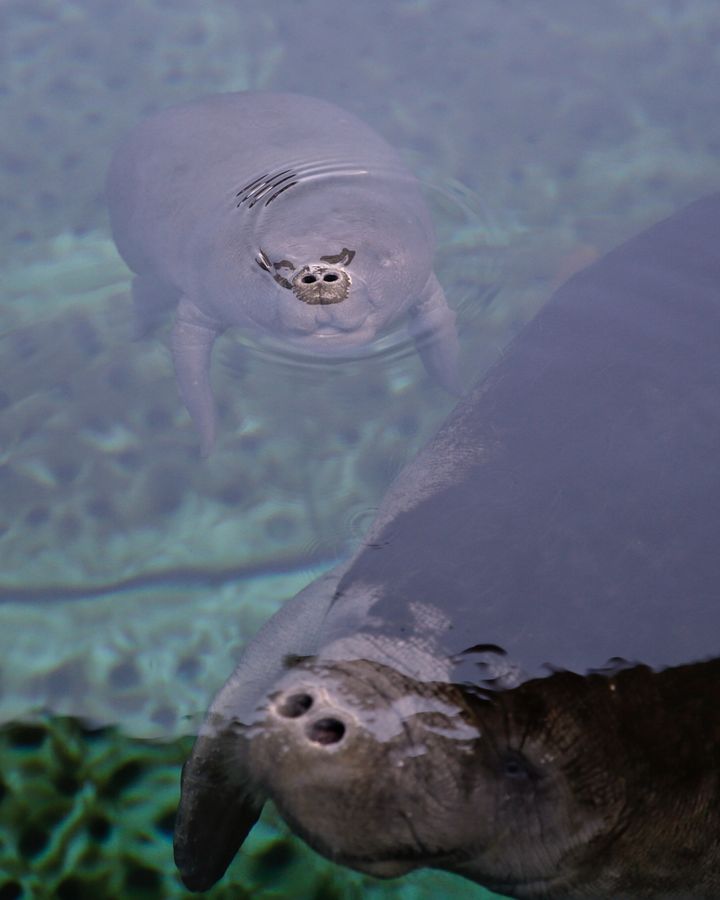
Numbers of the African manatee, pictured here in captivity, are in decline (Credit: Getty Images)
At every strategic corner of the bumpy earth roads around Dizangue, billboards carry messages alerting villagers and visitors to the Salvinia problem. Messages such as “Youths, Let’s Save Lake Ossa”; “Let’s Save Our Lake From Salvinia Invasion” appear on countless signs around the town. This may be Cameroon’s first experience of a Salvinia invasion, but there has already been an intensive response to it.
There are three main ways that the weed can be removed. The first, and most physically demanding, is removing it manually. “This includes hand-pulling, mostly for low infestation, and the use of specialised equipment, for high infestation,” says Fontem. “This method is labour-intensive, tedious and time-consuming.”
Since 2019, AMMCO has been mobilising locals to remove the plant manually to reduce the scope of spread. But it has not been without challenges. “This method is very demanding given that the invasive plant multiplies very quickly,” says Kamla. “We removed over 200 tonnes of Salvinia from the lake in 2019 and 2020. Yet, no impact was felt.”
This is because manual removal of Salvinia alone is not enough to control the weed, Lum says. Any plant left in the water will rapidly grow to replenish what has been stripped away.
The second option is chemical control, which involves the application of herbicides to kill the weed. But this comes with its own ecological drawbacks, as the herbicides pose a risk to other plants and could harm the lake’s other organisms. So far, the chemical approach has not been tried at Lake Ossa, and scientists including Fontem caution against trying it.
But there is one final option that could relieve Lake Ossa of Salvinia and restore its ecosystem: a small, brown-black water beetle native to Brazil known as the Salvinia weevil, which feeds almost exclusively on the weed. Measuring just 2-3.5mm long in its adult form, this tiny insect is equipped with a long, sturdy snout. But it is the weevil larvae that are devastating to the Salvinia by burrowing into the plant’s rootstalks and causing fatal damage.
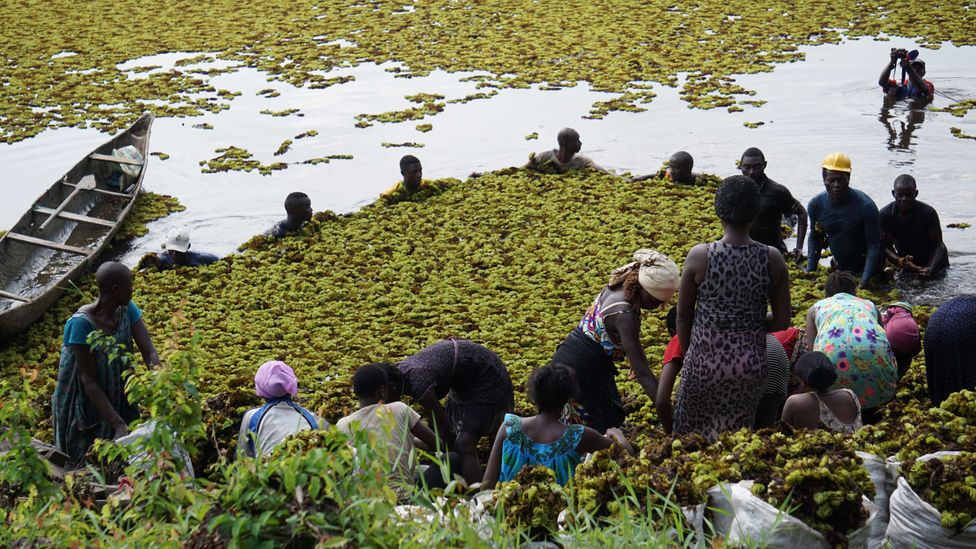
Removing Salivinia by hand is very labour intensive, but so far it is the only method that has been attempted at Lake Ossa (Credit: AMMCO)
The Salvinia weevil was discovered by Wendy Forno, a scientist at Australia’s government research agency CSIRO, while carrying out surveys in South America between 1978 and 1982. The first releases of the weevil as a biological agent to destroy Salvinia were at Lake Moondarra, Mount Isa, Australia in 1980, with remarkable success.
“Lake Moondarra is mostly clear of Salvinia today. Fifty thousand tonnes of Salvinia on the lake was killed by weevils over a 400-hectare (1.5-sq-mile) infestation,” says Matthew Purcell, director of the Australian Biological Control Laboratory, a facility run by the United States Department of Agriculture and CSIRO.
“The weevil – both adults and larvae – only feeds on this fern and not on other aquatic plants,” says Purcell. “As the plants increase seasonally, so do the weevils. The weevils [and] Salvinia constantly increase and decrease through the seasons in balance.” The weevils never fully eradicate the weed, but help to “return the system to a balance”, says Purcell.
The weevil was also deployed in the Senegal River in the early 2000s, where it had similar success, says Arnold Pieterse, formerly a senior staff member of the Netherlands’ Royal Tropical Institute, now retired. He, too, underlines that the weevils’ strong preference for Salvinia as a food crop makes it an appealing choice for Salvinia control. “It has irrefutably been proven that the insects do not form any danger to the environment or crops,” says Pieterse.
South Africa, too, has successfully brought Salvinia molesta under control thanks to the release of the weevil into its fresh water systems since 1985. “South Africa had a number of systems infested with the weed throughout the country, mainly smaller impoundments and rivers,” says Julie Coetzee, deputy director and manager of the Aquatic Weed Biocontrol Programme at Rhodes University, South Africa. These waters took between one to three years to clear, depending on the nutrients in the water, and the climate. “We still do have some infestations appearing,” Coetzee says, but “once weevils have been released, we typically get clearing with a season”.
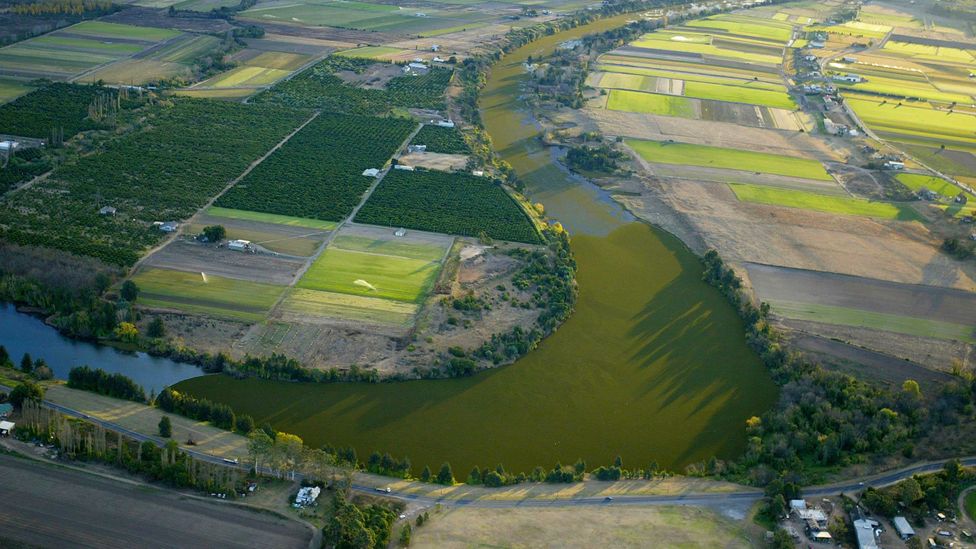
The Salvinia weevil was first tried as a method to control the weed in Australia, where it has also invaded rivers and lakes (Credit: Getty Images)
Though the Salvinia has no defence against the weevil, the weevils themselves have weaknesses. “No drawbacks were experienced initially but nowadays, we have noticed that there are sites where infestations have persisted, particularly in shaded sites,” says Coetzee. “We have also discovered a parasitic alga infecting [the weevil] population.” This alga, called Helicosporidium, reduces the weevil’s ability to reproduce.
Nevertheless, Coetzee is optimistic that weevils could clear Cameroon’s Lake Ossa of Salvinia. “Implementing a biological control programme in Cameroon is the most ecologically friendly, economically sustainable option for control of Salvinia,” she says. “Given the size of the infestation on the lake, it is going to take a while for the control agent populations to build up to sizes that will damage the plants, and cause them to sink. This is not a fast process. Patience is key.”
Purcell, too, is hopeful that the weevils could rejuvenate Lake Ossa. “The weevils should work in Cameroon. Most control is achieved within three years,” he says. “The control lasts indefinitely, much better than spraying which must be reapplied every year and every season, with negative consequences to the aquatic environment.”
It may not be much longer before Lake Ossa becomes the next Salvinia-ridden water body to welcome weevils. A task force involving several of Cameroon’s government ministries has been set up to oversee the eradication of Salvinia in the lake through the release of the weevils.
The local people of Lake Ossa, though, are frustrated at the pace of action. “Fishing is our only source of income. We are running out of patience,” says Jean Pierre Nga, a fisherman. Dora Sih, a fish seller in the business for 25 years, agrees: “Things are not moving.”
But in AMMCO and their partners’ facilities in Dizangue, the stock of weevils is steadily growing. “They will be released into the lake as soon as we receive the authorisation permit from the government,” Kamla says. “And we hope that after two or three years, we will overcome this invasive plant.”
—
The emissions from travel it took to report this story were 41kg CO2, travelling by bus and motorbike. The digital emissions from this story are an estimated 1.2g to 3.6g CO2 per page view. Find out more about how we calculated this figure here.
March 31st, 2021 at 6:14 am
Very good article.
I know many sudu farmers in South Africa,Kenya are raring birds and other creatures to go after locusts and other parasites that were decimating their crops.
When I owned the coconut estate at Dodangaslanda,to increase the income I planted chilis,bananas,pepper.Instead of spending money on fertilizers which I made on my own.Fewyears before that my US peace corp friends helped the villages to make compost using this Salvinia.I collected tons of it from Bathalagoda lake and other lakes and buried them with all the unwanted weeds that the cows didn’t eat and the compos we made was used for our plants.